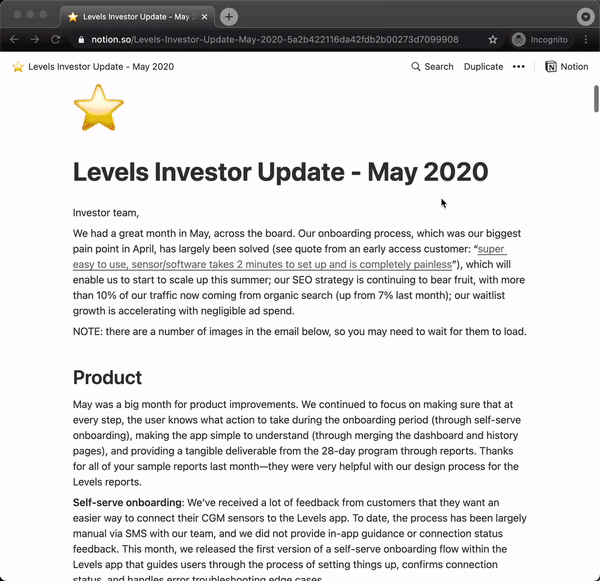tl;dr
We’re publishing all our monthly investor updates going forward with a 12-month delay, so you’ll get to see what Levels was like one year ago — all the way back to the very start of the company. We’ll publish the newest update on the 1st of every month.
We’re also publishing our team all-hands meetings, the Levels Friday Forum, after a 12-month delay. These will be published weekly.
In this article, we describe why we’re publishing our internal company documents, and how this helps us achieve our mission of solving the metabolic health crisis.
What are we sharing?
We’re publishing all of our historic investor updates from 12+ months ago to give people a look into the very early days of Levels. These are detailed monthly emails we compile for our investor network, sharing what’s happening throughout the company: product features and roadmap, financials, content, hiring, and more.
These updates go all the way back to August 2019, which was the second month of the company’s existence (we incorporated the company on June 25, 2019).
We’re publishing these investor updates as close to unfiltered as possible. The only information we’ve redacted is anything that might be covered by a third-party non-disclosure agreement (NDA); in practice, this only affects a handful of our updates. Most of these have no information redacted.
We’re also publishing our weekly all-hands meetings — the Levels Friday Forums — on a 12-month delay.

These are Zoom meetings in which we share updates from around the company, as well as things we’re excited about, personally and professionally. As a fully remote company from the beginning, it’s the one time the whole team is together. These videos give an even deeper look into the week-by-week changes in the company, from well before the days of product-market fit.
We’ve landed on a 12-month delay to reduce the risk of misunderstanding with third parties with whom we have pending agreements or other time-sensitive topics.
We publish more information about our company — including things that are more recent than 12 months, our thoughts on company building, company culture, team interviews, strategy, and a host of other topics — on our podcast A Whole New Level, and in other articles here on Medium.
5 Reasons to Build in Public
Transparency and openness are core to our company values and culture, but values don’t have meaning if they’re just slogans on the wall — you have to live them. Beyond values alignment, there are many other tangible benefits to being open.
1. Rigor
First, being transparent forces rigor. We publish our investor updates every month on the 15th, no exceptions. Sometimes there’s good news, sometimes bad news, but we always ship it.
In much the same way that hiring a personal trainer forces accountability on exercise, setting expectations for deliverables to external stakeholders — including investors and team members — can help to uphold accountability within the company.
“If I were to do Coinbase over again, I would do way more out in the open. It forces a lot of rigor.” — Brian Armstrong
We are committed to the rigorous process of producing content for all aspects of our company, much of which can be shared and therefore can feed into our culture of openness.
Building a culture of long-form documentation allows for better discoverability, shareability, efficiency, and alignment of all aspects of our company, from strategy to internal processes, to marketing.
Even for non-written communication, we emphasize recording conversations via Loom such that the information is evergreen and scalable. A substantial percentage of our meetings are recorded and distributed to the rest of the team.
Building a culture of memos over meetings enables openness and raises the bar for rigor. That content, in turn, feeds into keeping our community (investors, partners, members) engaged and in the loop, which builds trust.
2. Investor Confidence
Being transparent also gives investors a lot more to work with when making decisions. It’s hard for an investor to build confidence in you when you only give them a single data point. But if you can show them a steady drumbeat of progress month over month, it makes their decision a lot easier — or as Mark Suster says, invest in lines, not dots.
Look at things from the perspective of the investor. They’re often in a position where they have to make a significant, multi-million-dollar decision with very little information — often just one or two phone calls.
If you can provide them with confidence that you have answers to their questions and you can show consistent progress, you make their decision a lot easier. During our fundraising process, we were very transparent with those who were considering an investment and shared a substantial data room that covered all the frequently asked questions we would get from investors.
In our case, most of the angels/funds that ended up investing in Levels were people who had been following along for months. In the case of a16z, they invested in September and had been kept in the loop with our investor updates since February — a full eight months. (If you’re interested in learning more about how we approach fundraising, you should check out the two-part podcast on The Secret Science of Fundraising: Part 1 and Part 2.)
3. Recruiting
Making a career change is a big decision, and it’s not something that should be taken lightly. When thinking about what company to join, it’s easy to justify working at Google or Netflix because a lot of people do it, and you have reason to believe that working there will be a reasonably pleasant experience.
But if you need to decide whether you’ll join some small startup with a dozen employees, what information do you have to go on? Usually, not a lot. You have a couple of phone calls with people on the team, you do a technical interview, then you get an offer.
Often, it feels like the company is assessing you, but the conversation should be in both directions. It’s the company’s responsibility to have empathy for the substantial decision that lies ahead of you and to make sure that as a potential hire, you have enough information to make the right choice — even if that choice is a “no”.
Making the wrong hire is bad for the company, but it’s especially bad for the person you hired who put their trust in you. There are few things worse than joining a company only to quickly discover that a lot of what you were told turned out to be untrue, or that the culture is not a fit.
One of the common things we hear from new hires at Levels is that there are no surprises when they join. To paraphrase the feedback we’ve received from many of our new team members, “I felt like I already knew everyone on the team before I started” and “I feel like I know more about Levels and the team after working here for two weeks than I did at my last company after working there for five years!”
Being transparent shows people what the team and culture are really like; it’s been our secret weapon in recruiting world-class talent.
4. Brand
We want to earn the trust of our members and being transparent about the good and the bad helps us build that trust.
We’re building a movement and we want our members to know that they’re part of that movement. It’s not unusual for a customer to give us a piece of feedback and then to see that piece of feedback implemented in the app a few days later.
We engage with our customers and learn from them every day. We have an internal initiative at the company called Everyone on Community, in which all team members participate in calls with our members. That’s just one of almost a dozen projects designed to capture feedback from our members in different forms.
If you’re working on something that’s mission-driven, people will want to help you succeed. Being transparent about your process lets people feel connected to your company in a way that’s not possible otherwise. It’s a lot harder to get people to care than it is to keep things secret.
We want our members to feel like they’re contributing to a brighter future — because they are! We really couldn’t do it without them. Our company and product are built on the willingness of our members to give us feedback and direction.
5. Inspiring Other Entrepreneurs
We want our story to be a resource for entrepreneurs in the technology ecosystem and we want to encourage more people to start companies.
We’re hoping that giving other entrepreneurs an inside look into the early days of Levels will give people the confidence to take the risk. In the early days, Levels was just a small group of people thinking through how to solve a big problem.
There are far fewer downsides to starting a company than most people think. The odds that you’ll fail are extremely high — by most estimates, more than 90% of startups fail — but you’ll learn far more than you can anywhere else and it opens up a world of opportunity.
In fact, at Levels, if we’re assessing a candidate that has a Founder background — regardless of the outcome of the company — it’s a huge plus because it shows that they know what it takes to work in an ambiguous environment where things are constantly changing.
Perceived Risks
It feels risky to publish this kind of information publicly — especially when almost no other companies do it. It’s a safe assumption that if there’s a thing that nobody else in the industry does, there’s probably a reason for it.
But just because nobody else is doing it doesn’t mean it isn’t worth doing. In many ways, this is the nature of entrepreneurship. It’s about questioning assumptions around how things have been done and taking a risk that there’s an opportunity others have overlooked.
And there are real risks in doing things well outside the norm. Here’s a note from a General Partner at a $1B+ venture capital firm that passed on our Seed Round: “I have to comment that it feels like you are being overly disclosive. You are literally past the 3 sigma to the right on disclosure even for companies I am on the board of… I don’t think it is in your best interest to disclose quite this much…”
Most of the downsides are ambiguous, and it’s often the ambiguity that makes people feel uncomfortable. There are so many questions that come up… What if people find out that we’re not as big as they thought we were? What if our revenue numbers are lower than people thought?
But at the end of the day, you need to weigh the tangible benefits of transparency with the ambiguous potential costs and make a decision as to whether it’s the right decision for your company. In our case, it’s a clear “yes.”
Competition
Probably the most common concern we hear from people when we tell them about how open we are with our information is something along the lines of, “What if your competitors get access to your strategy and other company data?”
To be honest, we don’t spend much time internally thinking about competitors. To steal a mantra from Amazon, we’re customer-focused, not competitor-focused. We spend most of our time talking to our members, learning from them, and building and shipping new versions of the product. When you’re the market leader, you need to build your company looking forward, not building while looking in the rearview mirror.
“The number one thing that has made us successful by far is obsessive-compulsive focus on the customer as opposed to obsession over the competitor” — Jeff Bezos
Metabolic health is the single biggest health crisis in the world. If we’re going to solve this, we need hundreds of companies approaching it from every angle. The more companies working on this problem, the better.
It’s also worth pointing out that our strategies are not new or original. It’s not a secret that people listen to podcasts, or that you can use social media for distribution, or that content and SEO are a scalable way to build top of funnel… but saying it and doing it are very different. Ideas are cheap, execution is hard.
“Historically, disruptive technologies involve no new technologies; rather, they consist of components built around proven technologies and put together in a novel product architecture that offers the customer a set of attributes never before available.” — The Innovator’s Dilemma
Scrutiny
There’s a perception that if you publish information, it will be used against you in the future — especially when you’re in a heavily regulated industry like healthcare. It’s very possible that a journalist will find something in the content you produce, take something out of context, and write something negative about the company.
That said, negative press is inevitable whether you make things public or not. When you’re impacting a billion people and inventing a new category, it’s inevitable that some people won’t like what you do, or that you’ll make honest mistakes along the way. If you want to build a company that changes the world, you need to have the courage to be disliked and grow a thick skin. There’s no way around it.
Criticism is inevitable, and the best defense against criticism — good or bad faith in nature — is transparency and a track record of honest communication.
Being transparent insulates you from criticism born of lack of context because the context is fully available for anyone to see. Your transparency has also hopefully built loyalty among your community, who will be willing to share positive comments and experiences.
Another concern, especially in regulated industries like healthcare, is that being transparent gives more material for regulators to use against you. There is some truth to this, but one should also remember that regulators are not your enemy.
Regulators want the same outcomes that you do — in our case, the regulators want to make sure that our product is safe for consumers, so it’s our responsibility to work with them to make sure that the product is safe and that we’ve provided them enough information to make an informed decision.
If you show that you’re operating in good faith and that you’re doing your best to stay within the rules and regulations, that goes a long way with regulators. Being transparent and honest builds confidence.
Our mission is to solve the metabolic crisis, and we are doing this by building a movement of individuals empowered to understand and optimize their health through access to their personal data.
We want our members to be part of the process of solving this global-scale problem, and we’re hoping that building in public will give them confidence in our ability to execute.
If you want to learn more about the science of metabolic health, check out the Levels Blog and to find out more about how we built Levels, check out our Inside the Company page.








